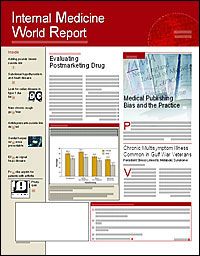Publication
Article
Internal Medicine World Report
Self-management of Oral Anticoagulation a Viable Option
Author(s):
Self-managed oral anticoagulation can be safe and reliable for many patients, provided they receive appropriate training. It can also increase the amount of time spent within the therapeutic range for those who have poor control to begin with, according to a large study from the United Kingdom that was re­cen­tly published in the British Medical Journal (2005;331: 1057-1059).
The large number of individuals currently taking warfarin in the United Kingdom, estimated at 950,000, and the fact that monitoring anticoagulation in these patients is expected to increase by a factor of 5 over the next decade, prompted lead investigator D. A. Fitzmaurice, MD, of the Department of Primary Care General Practice, Univer­sity of Birmingham, and colleagues to examine the utility of self-anticoagulation. In­cluded were 617 patients (aged ?18 years) selected from primary care centers within the UK Midlands Research Consortium who had been receiving warfarin for at least 6 months with a ­target international normalized ratio (INR) of 2.5 or 3.5. They were randomized to intervention (n = 337) or routine care (n = 280).
Patients in the intervention group attended 2 nurse-led training sessions that covered the theory of anticoagulation, the INR and its targets, how to measure and interpret INR, how to adjust dosages, and quality control. After the sessions, those who were deemed capable of self-management were given home testing equipment.
Patients in the intervention group managed their own anticoagulation for 12 months and tested their INR every 2 weeks. They were instructed to perform internal quality control tests if they received any unusual INR results. Patients in the intervention group were seen every 3 months to monitor pro­gress, while those in the routine care group continued to go to either the hospital or practice-based anticoagulation clinics.
In the intent-to-treat analysis, there were no major differences in mean percentage of time within the therapeutic range for INR between prestudy and study periods in either group (P = .12). INR control based on mean percentage of time within the therapeutic range did not differ significantly between the intervention group and routine care group (70% vs 68%, respectively; P = .18).
Patients who had poor control before enrolling in the study and who were in the intervention group showed an improvement in control that was not observed in the group receiving routine care.
Adverse events were comparable, affecting 9 patients in the self-management group and 7 in the routine care group (P = .89).
“With appropriate training, self-­management is safe and reliable for a sizable proportion of patients receiving oral anticoagulation treatment,” the authors wrote.





